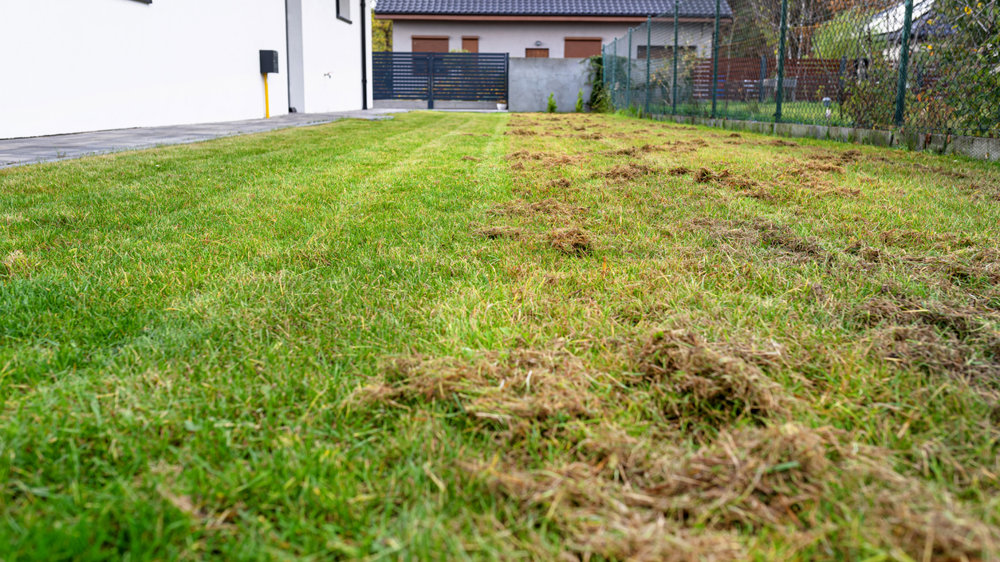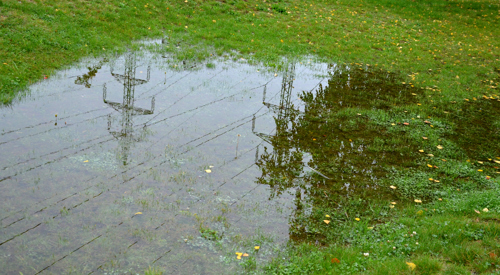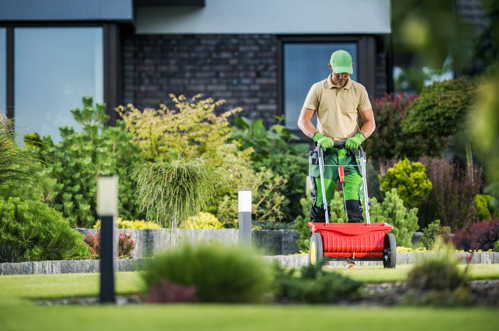When should you scarify a lawn and how to revive it afterwards
28 Mar Landscaping & Turfcare
As a professional landscaper, your expertise encompasses the care and maintenance of outdoor spaces, ensuring the health and vibrancy of your clients' lawns and green spaces.
There's no shortage of tasks that need to be completed around the landscaping calendar, with each one needing to be timed at the most opportune moment to have the greatest effect. Scarification is no different, standing as a cornerstone in maintaining a healthy lawn.
It’s a practice most landscapers will be familiar with. Though not part of your day-to-day lawn care schedule, scarifying is an important task for maintaining healthy lawns. If you’re new to landscape maintenance, or simply looking to improve your knowledge of the process, this guide will give you an overview, providing you with useful tips and advice. If your clients are not quite convinced of the necessity of scarification, sharing this guide might help explain why it’s essential!
Why is scarification important?
Scarification is an essential practice to remove thatch and rejuvenate lawns.
Thatch buildup, consisting of dead excess grass, roots, and debris accumulating on the soil surface, poses a significant challenge to lawn health. While a thin layer of thatch can benefit the lawn by providing insulation and protection, excessive buildup of surface thatch impedes essential processes such as water infiltration, air circulation, and nutrient absorption.
This, in turn, can lead to poor drainage, increased disease susceptibility, and inhibited grass growth. Scarification serves as a vital corrective measure, removing the excess thatch and fostering an environment for healthy grass growth.
When is the best time to scarify?
As previously mentioned, precise timing is everything when it comes to most lawn maintenance tasks.
Timing scarification right will give your clients' lawns and green spaces the best chance of a successful recovery. Scarifying at the wrong time, such as during periods of high heat, can potentially damage the grass by disrupting its growth and recovery processes.
Scarify lightly in spring
Spring is a good time for light thatch removal or light scarifying, as well as moss removal. In spring, typically as temperatures rise in April or late March, you'll see grass growth and recovery rates surge, making it an ideal period to scarify.
Landscapers may also opt to do some heavier scarification in shadier areas which are likely to be impeded by thicker foliage and fallen leaves later in the year. In spring these typically shaded areas have better access to sunlight giving them their best chance at recovery, making it a good opportunity for any new grass seed to grow.
Opt for heavier scarification in autumn
Scarification can do a world of good for any green space affected by thatch, but it can also open the door to other issues such as weed infestation.
That's why many landscapers will opt to complete deeper scarifying and heavy raking in early autumn instead of spring, even though they are more likely to face bad weather and are outside of the optimum growth window.
Heavy scarifying can significantly thin the lawn and leave soil exposed – the ideal spot for a seed bed. While that may be a great opportunity to see new grass seeds thrive, you may inadvertently be creating the perfect home for summer weeds. The seed bed can soon become a weed bed!
It's something that can be avoided with careful maintenance, but if you want to bypass the issue altogether, you may consider holding off on any heavy scarification until autumn.
Signs that you need to scarify

Seasonal changes and the corresponding weather conditions play a huge role in when to scarify your lawn, but they're not the only indicators. If your clients' grass areas exhibit any of the following, it may be time to scarify.
- If there's a visible buildup of thatch between grass blades and soil, exceeding half an inch in thickness.
- There's evidence of poor water drainage; the presence of puddles or standing water after rainfall or irrigation.
- There are noticeable signs of weakened or patchy grass growth despite routine maintenance efforts, such as mowing and fertilisation.
How to help a lawn recover from scarification
Though often a necessary step in the landscaping calendar (particularly in milder climates!), the process of scarification can be stressful to your client's lawn. As well as timing it right, there are a few other measures you can take to ensure your clients' grounds spring back in no time.
Mow before you scarify
For the best chance to make scarification a success, the process begins the week prior with careful preparation.
Begin by mowing the area you plan to scarify, taking the grass down to a shorter length than you would usually. This step will not only remove excess grass and expose the underlying thatch layer, it can slice up patches of thatch making them easier to remove later.
After mowing, be sure to clear the lawn surface of debris such as twigs, leaves and any other organic matter, especially if you are scarifying in autumn. This step will ensure the scarification process can be completed without a hitch, allowing for a thorough and effective treatment.
Apply chemical-free moss killer
After prepping the lawn with mowing, you can apply a layer of chemical-free moss killer that is made from natural oils and starches.
This proactive step serves to eradicate existing moss, preventing further spread during scarification. By eliminating it beforehand, you not only set yourself up for a smoother scarification process, but also prevent a potential reinfestation of moss later down the line, promoting healthier turf growth and a more robust lawn overall.
Select the right equipment
The choice of scarification equipment is contingent upon factors such as the size of the lawn and the severity of thatch buildup. For smaller lawns or areas with minimal thatch, manual scarifiers equipped with sharp blades may suffice.
For those larger lawns typically tackled by landscape professionals, however, or for clients with significant thatch accumulation, it may be time to bring in powered scarifiers equipped with rotating tines or blades for efficient removal.
Invest in a scarifier attachment
If you are using a ride-on mower or lawn tractor, or a front mower, you can invest in a handy scarifying attachment that turns your machine into the exact tool you need to tackle the job. Scarifying in this way allows you to cover a lot of space quickly – the ideal solution for larger green spaces.
Steps to take after scarification
As previously mentioned, scarification, though necessary, can be difficult for your client's lawn, so conducting the proper aftercare maintenance is a must.
Here are a few steps you can take to help get the recovery period well underway.
Overseed as necessary

A by-product of thorough scarification is that it can expose bare patches or thin areas in the lawn. If this is the case, overseed to promote uniform grass coverage and expedite recovery.
Choose high-quality grass seed suitable for the lawn's specific conditions and apply it evenly to the affected areas – if you’re in a climate expecting intense summer heat, consider investing in drought-resistant grass seeds. Ensure adequate soil moisture to facilitate germination and establishment of the new grass seedlings. To do so, you’ll most likely need to advise your clients to water the area regularly unless there’s a period of rain directly after overseeding.
Adjust subsequent landscape maintenance
Maintaining an optimal mowing height is essential for facilitating the lawn's recovery process and ensuring its long-term health and vitality.
With this in mind, during subsequent visits to your client's property keep a keen eye out for any emerging issues that may require attention. You may need to make adjustments to the mowing height to support new growth and avoid cutting too low, as this can hinder the lawn’s ability to bounce back effectively.
Mastering scarification
The meticulous execution of scarification and post-recovery maintenance is often the difference between an unhealthy and thriving lawn – in milder climates prone to developing thatch, it’s vital for maintaining the long-term health and vitality of your clients' lawns.
By following the guidelines outlined you can slot the task into your spring and autumn lawn care maintenance plans with expert ease. The result of your hard work? Revitalised lawns and the cultivation of lush, vibrant outdoor spaces that enhance the beauty and enjoyment of any landscape you may be working on. Once you’ve transformed the lawn, make sure to share the results of your work with us on social media!
Considering investing in reliable equipment to tackle scarifying on a larger scale? Explore equipment Powered by Kawasaki for machinery that you can trust to get the job done.






